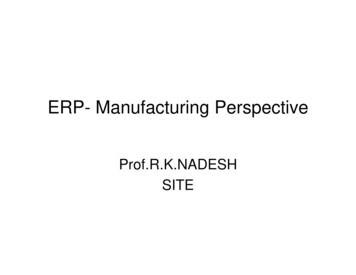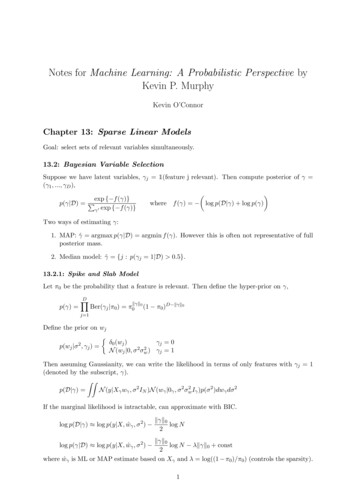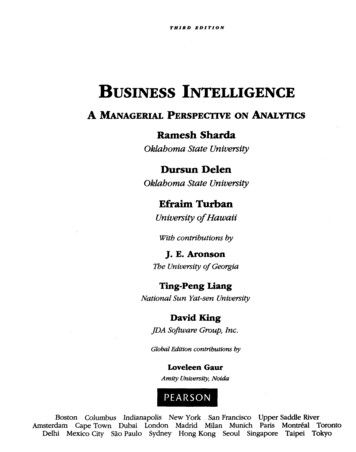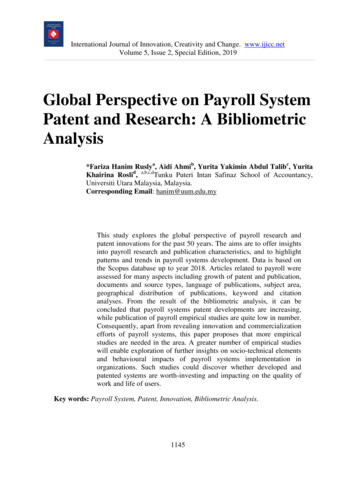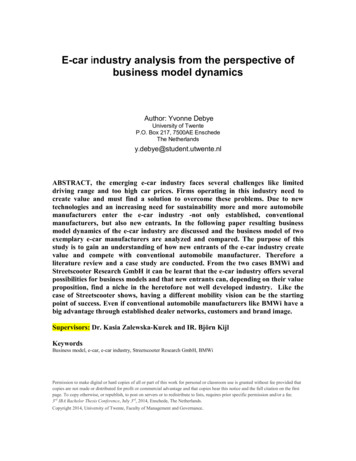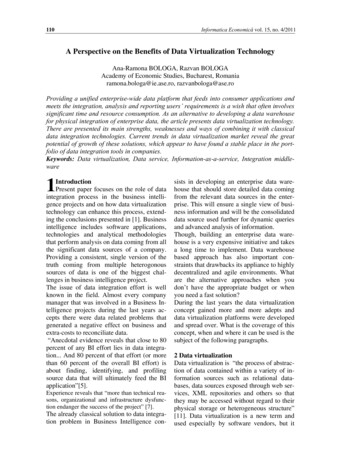
Transcription
Informatica Economică vol. 15, no. 4/2011110A Perspective on the Benefits of Data Virtualization TechnologyAna-Ramona BOLOGA, Razvan BOLOGAAcademy of Economic Studies, Bucharest, Romaniaramona.bologa@ie.ase.ro, razvanbologa@ase.roProviding a unified enterprise-wide data platform that feeds into consumer applications andmeets the integration, analysis and reporting users’ requirements is a wish that often involvessignificant time and resource consumption. As an alternative to developing a data warehousefor physical integration of enterprise data, the article presents data virtualization technology.There are presented its main strengths, weaknesses and ways of combining it with classicaldata integration technologies. Current trends in data virtualization market reveal the greatpotential of growth of these solutions, which appear to have found a stable place in the portfolio of data integration tools in companies.Keywords: Data virtualization, Data service, Information-as-a-service, Integration middleware1IntroductionPresent paper focuses on the role of dataintegration process in the business intelligence projects and on how data virtualizationtechnology can enhance this process, extending the conclusions presented in [1]. Businessintelligence includes software applications,technologies and analytical methodologiesthat perform analysis on data coming from allthe significant data sources of a company.Providing a consistent, single version of thetruth coming from multiple heterogonoussources of data is one of the biggest challenges in business intelligence project.The issue of data integration effort is wellknown in the field. Almost every companymanager that was involved in a Business Intelligence projects during the last years accepts there were data related problems thatgenerated a negative effect on business andextra-costs to reconciliate data.“Anecdotal evidence reveals that close to 80percent of any BI effort lies in data integration. And 80 percent of that effort (or morethan 60 percent of the overall BI effort) isabout finding, identifying, and profilingsource data that will ultimately feed the BIapplication”[5].Experience reveals that “more than technical reasons, organizational and infrastructure dysfunction endanger the success of the project” [7].The already classical solution to data integration problem in Business Intelligence con-sists in developing an enterprise data warehouse that should store detailed data comingfrom the relevant data sources in the enterprise. This will ensure a single view of business information and will be the consolidateddata source used further for dynamic queriesand advanced analysis of information.Though, building an enterprise data warehouse is a very expensive initiative and takesa long time to implement. Data warehousebased approach has also important constraints that drawbacks its appliance to highlydecentralized and agile environments. Whatare the alternative approaches when youdon’t have the appropriate budget or whenyou need a fast solution?During the last years the data virtualizationconcept gained more and more adepts anddata virtualization platforms were developedand spread over. What is the coverage of thisconcept, when and where it can be used is thesubject of the following paragraphs.2 Data virtualizationData virtualization is “the process of abstraction of data contained within a variety of information sources such as relational databases, data sources exposed through web services, XML repositories and others so thatthey may be accessed without regard to theirphysical storage or heterogeneous structure”[11]. Data virtualization is a new term andused especially by software vendors, but it
Informatica Economică vol. 15, no. 4/2011111hides the old idea of data federation as animportant data integration technology.It can be used in a variety of situations thatrequire unified access to data in multiple systems via high-performance distributed queries. This includes data warehousing, reporting, dashboards, mashups, portals, master daReportingtoolsBItoolsta management, SOA architectures, post- acquisition systems integration, and cloudcomputing [3]. Of course the tools used today for data federation are much more powerful and the technologies used are differentbut the idea was used much before.Portals anddashboardsService orientedapplicationsData virtualization layerData warehouseDatamartsVirtual viewsData servicesETL ServerFilesRDBMSERP/CRMLegacy systemsXMLFig. 1. Data virtualizationIn ‘80s, database vendors developed databasegateways for working with ad-hoc queries onmultiple heterogonous databases.In ‘90s, software vendors tried to create virtual data warehouses applying data federation. At the time, the integration of data coming from legacy systems was almost impossible without using a new data store.In 2000s, Enterprise Information Integration(EII) proposes an architecture that allowscollection of data from a various data sourcesfor providing some reporting and analysisapplications with the required information.This architecture focuses on viewing theright information in the right form by movingonly small pieces of data. EII was not scalable, it was designed to offer point-to-point integration, so once two applications were in-tegrated and a new application is added in thesystem, the integration effort must be repeated.In the recent years data federation has alsobeen called data services or information as aservice. Service oriented architectures usedata federation as a data service that abstractsback-end data sources behind a single queryinterface. Data services offer a flexible dataintegration platform based on the new generation of standards or services that allows access to any data type, located on any platform, using a great variety of interfaces anddata access standards. But data services canoffer more than that: support for a single version of the truth, real time business intelligence, searching throughout all company’sdata, high level security in accessing sensi-
112tive data.Moreover, you can bind the virtualized datato additional function behavior, and thus create very powerful reusable data services thatagain can be mixed and matched to create solutions [6].Advanced data virtualization brings an important progress in power and capabilities. Itabstracts data contained in a variety of datasources (databases, applications, data warehouses) and stores the metadata in a persistent metadata directory in order to offer asingle data access point.Data virtualization involves capabilities like: Abstracting of information related to thetechnical aspects of stored data, like location, storage structure, access language,application programming interfaces, storage technology and so on. Data are presented to consumer applications in a consistent way, regardless of native structureor and syntax that may be in use in theunderlying data sources. Virtualization of data sources (databases,Web content and various application environments) connection process, makingthem logically accessible from a singlepoint, as if they were in one place so thatyou can query that data or report againstit. Transformations for improving data quality and integration for collecting datafrom multiple distributed sources. Federation of data sets coming from various, heterogonous source systems (operational data or historical data or both). Flexibility of data delivery as data services are executed only when users request them. Presentation of the required data in a consistent format to the front-end applications either through relational views or bymeans of Web services.Also, data virtualization capabilities deliverycomes together with capabilities for data security, data quality and data management requirements, for queries optimization, caching, and so on.Data virtualization process involves twophases:Informatica Economică vol. 15, no. 4/20111. Identification of data sources and of theattributes that are required and available forthe final application. If there are more thanone data source that can provide the requireddata, the analyst will decide which of thesources is more trusted and will be used inbuilding the response. Data virtualizationtool will be used for designing a data modelthat defines the entities involved and createsphysical mappings to the real data sources.Advanced data virtualization tools will createa business object model as they use objectoriented modeling for internal representationof every stored data structure (even the relational data) which enhances many applications through the power of objects.2. Application of the data model in the second step for getting data from various datasources in real time when there is a client application query. The language used for querydescription can be any standard languageused by the data virtualization tool.3 Federation vs. IntegrationThe traditional way of integrating data inbusiness intelligence project consisted in developing a data warehouse or a collection ofdata marts. That involved designing new datastorage and using some ETL tools (Extract,Transform and Load) to get the required datafrom the source systems, clean them, transform them to satisfy the constraints of thedestination system and the analysis requirements and, finally, load them into the destination system. Usually, developing an enterprise data warehouse takes at least severalmonths and involves important financial andhuman resources, but also a powerful hardware infrastructure to support the storage andthe processing in seconds of terabytes of information. Data integration has also somespecific advantages: data quality and cleaning, complex transformations.Data virtualization software uses onlymetadata extracted from data sources andphysical data movement is not necessary.This approach is very useful when data storesare hosted externally, by a specialized provider. It allows real-time queries, rapid dataaggregation and organization, complex anal-
Informatica Economică vol. 15, no. 4/2011ysis, all this without the need of logical synchronizations or data copying.It is better to use to use virtualization tools tobuild a virtual data warehouse or to use ETLtools to build a physical data warehouse?Data virtualization is recommended especially for companies that need a rapid solutionbut does not have the money to spend forconsultants and infrastructure needed by adata warehouse implementation project.Using data virtualization the access to data issimplified and standardized and data are retrieved real-time from their original sources.The original data sources are protected asthey are accessed only trough integratedviews of data.But data virtualization is not always a goodchoice. It is not recommendable for applications that involve large amounts of data orcomplex data transformation and cleaning, asthose could slow down the functioning ofsource systems. It is not recommended ifthere is not a single trusted source of data.Using unproven and uncorrected data cangenerate analysis errors that influence decision making process and can generate important losses for the company.But, data virtualization can also complementthe traditional data warehouse integration.Here are some examples of ways of combining the two technologies whose practical application has proved to be very valuable [12]:a. Reducing the risk of reporting activityduring data warehouse migration orreplacement by inserting a virtual levelof reporting between data warehouse andreporting systems. In this case, data virtualization makes it possible to continueusing data for reporting during the migration process. Data virtualization can helpreducing costs and risks by rewriting report queries for data virtualization software instead of old data. When the newdata source is ready, the semantic layer ofdata virtualization tool is updated to pointthe new data warehouse.b. Data preprocessing for ETL tools asare not always the best approach for loading data into warehouses. They may lackinterfaces to easily access data sources113c.d.e.f.g.(e.g. SAP or Web services). Data virtualization can bring more flexibility by developing data views and data services asinputs to the ETL batch processes and using them as any other data source. Theseabstractions offer the great advantage thatETL developers do not need to understand the structure of data sources andcan be reused any time it is necessary.Virtual views and data services reuse leadto important cost and time savings.Virtual data mart creation by data virtualization which significantly reduce theneed for physical data marts. Usually,physical data marts are built around datawarehouse to meet particular needs ofdifferent departments or specific functional issues. Data virtualization abstractsdata warehouse data in order to meet consumer tools and users integration requirements. A combination of physicaldata warehouse and virtual data martscould be applied to eliminate or replacephysical marts with virtual ones, such asstopping rogue data mart proliferation byproviding an easier, more cost-effectivevirtual option.Extending the existing data warehouseby data federation with additional datasourcing, also extending data warehouseschema. Complementary views are created in order to add current data to the historical data warehouse data, detailed datato the aggregated data warehouse data,external data to the internal data warehouse data.Extending company master data, as data virtualization combines master data regarding company’s clients, products,providers, employees and so on with detailed transactional data. This combination brings additional information to allow a more comprehensive view of company activity.Multiple physical data warehouse federation as data virtualization realizes logical consolidation of data warehouses bycreating federated views to abstract andrationalize schema designs differences.Virtual integration of data warehouse
114in Enterprise Information Architectures which represents the company’sunified information architecture. Datavirtualization middleware forms a levelof data virtualization hosting a logicalscheme that covers more consolidatedand virtual sources in a consistent andcomplete way.h. Rapid data warehouse prototyping asthey data virtualization middlewareserves as prototype development environment for a new physical data warehouse. Building a virtual data warehouseleads to time savings compared to the duration involved in developing a real datawarehouse. The feedback is quick and adjustments can be made in several iterations to complete a data warehouseschema. The resulted data warehouse canbe used as a complete virtual test environment.So, data visualization represents an alternative to physical data integration for somespecific situation, but can always come andcomplement the traditional integration techniques.Could these solutions be somehow combinedin a single one, so we get both sets of advantages? The answer is positive, if therewas a way of using the semantic model fromdata virtualization for applying ETL qualitytransformations on real time data. This wouldmean a single integration toolset integratingboth virtualization and data integration capabilities. This is the solution that integrationvendors are reaching after.4 Data virtualization tools4.1 Market analysisThe data virtualization market currentlystands at around 3.3 billion and it will growto 6.7 billion by 2012, according to Forrester Research [8].The Forrester study of data virtualizationtools market indicates as top vendors Composite Software, Denodo Technologies, IBM,Informatica, Microsoft, and Red Hat. Thesetop vendors can be grouped in two categories: large software vendors (IBM,Informatica, Microsoft, and Red Hat) whichInformatica Economică vol. 15, no. 4/2011offer broad coverage to support most usecases and data sources and smaller, specialized vendors (Composite Software, DenodoTechnologies, and Radiant Logic) whichprovide greater automation and speed the effort involved in integrating disparate datasources.Fig. 2. Data virtualization tool vendors [8]Other BI vendors support data federation natively, including Oracle (OBIEE) andMicroStrategy. Most popular integrationtools providing data federation features are:- SAP BusinessObjects Data Federator;- Sybase Data Federation;- IBM InfoSphere Federation Server;- Oracle Data Service Integrator;- SAS Enterprise Data integrationServer.Data virtualization options offered by thesetools are much diversified, including:- federated views;- data services;- data mashups;- caches;- virtual data marts;- virtual operational data stores.They support a range of interface standards,including REST, SOAP over HTTP, JMS,POX over HTTP, JSON over ODBC, JDBC,ADO.NET and use many optimization techniques to improve their performances, including rule-based and cost-based query-
Informatica Economică vol. 15, no. 4/2011optimization strategies and techniques: parallel processing, SQL pushdown, distributedjoins, caching or advanced query optimization.An analysis of the companies implementingor intending to implement data integrationsolutions reveals some dominant markettrends [4][5]:a. Maximum exploitation of the already existing technology, as many companies donot wish to create a special platform fordata integration and prefer to use the existing components and processes for starting such an initiative.b. Focus on read-only use cases, as mostdevelopers use this approach deliveringvirtualization solutions for real timebusiness intelligence, a single version ofthe truth providing, federated views andso on. Still, the offer of read-write virtualization solutions has increased in recentyears.c. An increasing interest in using cloudcomputing, as most of data services providers already offer REST support, allowing “on-premise” integration. For themoment, there were used basic cloudbased services for solving simple integration tasks for organizations with restricted resources. But big organizations arealso interested in cloud-based infrastructures as a way of offering non-productionenvironments for the integration solutionsthey use.d. Data integration tools market and dataquality tools market convergence is moreaccelerated. Both types of tools are necessary for initiatives in business intelligence, master data management or application modernization. Most companiesthat have purchased data integration toolshave also wanted data quality features.The following section will briefly present adata virtualization solution in order to capture the complexity and main capabilities ofsuch solutions and to illustrate the importance of its integration with other tools forworking with integrated data at enterpriselevel.1154.2 Composite Software solutionComposite Software solution seems to be oneof the most complete and competitive solutions for data virtualization available on themarket on this moment. This fact has alsobeen reflected in the analysis realized by theForrester Group described above. At least,Composite is the leader pure play vendor inthe marketplace.Composite Software was founded in 2002and was for many years a niche player withits specialized product for data virtualization.The Composite Data Virtualization Platformis data virtualization middleware that ensuresa unified, logical virtualized layer for disparate data sources in the company.Composite platform is based on views, whichare relatively simple to define. After definingviews it can automatically generate SQLcode or WSDL code. It offers pre-packagedinterfaces for the leading application environments in order to simplify the integrationeffort. It also provides some very useful outof-the-box methods, such as SQL to MDXtranslators and methods for simplified accessto Web content.It offers support for SQL and XML environments but also for legacy environments, flatfiles, Web content and Excel.Its architecture, presented in Fig. 3, has twomain components, both of which are pure
Informatica Economic ă vol. 15, no. 4/2011 113 ysis, all this without the need of logical syn-chronizations or data copying. It is bett


